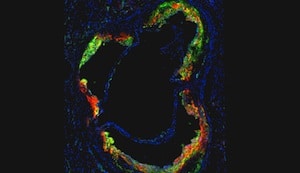
Nanoparticles designed for drug delivery run the gamut from very artificial components like gold or specially designed RNA to particles that adapt or mimic naturally occurring nanoparticles. A noteworthy example of the latter is adapting biology’s “good cholesterol”, the high-density lipoprotein particle, to deliver anti-inflammatory drugs to prevent recurrent heart attacks and strokes. A hat tip to Newswise for reprinting this Mount Sinai news release “Novel Nanotherapy Breakthrough May Help Reduce Recurrent Heart Attacks and Stroke“:
Up to 30 percent of heart attack patients suffer a new heart attack because cardiologists are unable to control inflammation inside heart arteries — the process that leads to clots rupturing and causing myocardial infarction or stroke.
But a report in Nature Communications [abstract] by Icahn School of Medicine at Mount Sinai scientists showcases the development of a new technology that may provide a solution to this high risk of repeat heart attacks — and potentially help save more lives.
An international research team, led by Mount Sinai investigators, designed and tested a high-density lipoprotein (HDL) nanoparticle loaded with a statin drug. In mouse studies, they show this HDL nanotherapy is capable of directly targeting and lowering dangerous inflammation in blood vessels.
Not only could the HDL nanotherapy potentially avert repeat heart attacks, it may also have the power to reduce recurrent strokes caused by clots in brain arteries, says the study’s senior investigator, Willem Mulder, PhD, Associate Professor of Radiology in the Translational and Molecular Imaging Institute at the Icahn School of Medicine at Mount Sinai.
“We envision that a safe and effective HDL nanotherapy could substantially lower cardiovascular events during the critical period of vulnerability after a heart attack or stroke,” says Dr. Mulder.
“While we have much more to do to confirm clinical benefit in patients, our study shows how this nanotherapy functions biologically, and how this novel concept could potentially also work in the clinical setting to solve a critical problem,” says Dr. Mulder. “This nanotherapy would be the first of its kind.” …
According to Mount Sinai researchers, the best way to use their HDL nanotherapy is by injection after the clot that produces a heart attack or stroke has been treated. The HDL nanoparticle would deliver the statin directly to macrophages that are driving the inflammatory response. “This could potentially and very rapidly stabilize a dangerous situation,” Dr. Mulder says. “In addition, after discharge, patients would continue to use their oral statins to control LDL in their blood.”
“Our study also confirms that the HDL nanoparticle is not seen as a foreign invader by the body’s immune system and that it has an inherent and natural affinity to target plaque macrophages,” says Jun Tang. “Our experiments demonstrated a very rapid reduction in inflammation in mice with advanced plaque buildup.”
Rather than the classical image (for example, here) in which an advanced medical nanorobot, made using atomically precise manufacturing technology that does not yet exist, mechanically chews away at atherosclerotic plaques, this work may lead to near-term nanomedicine in which modified natural nanostructures exploit biological mechanisms and current drugs to minimize damage from atherosclerotic plaques. Nevertheless, I would still love to see the advent of advanced nanomedical robots.
—James Lewis, PhD

